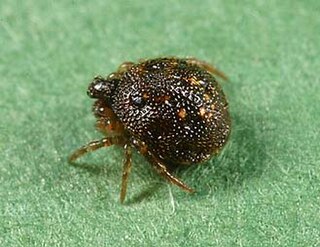
Theridiidae, also known as the tangle-web spiders, cobweb spiders and comb-footed spiders, is a large family of araneomorph spiders first described by Carl Jakob Sundevall in 1833. This diverse, globally distributed family includes over 3,000 species in 124 genera, and is the most common arthropod found in human dwellings throughout the world.

Episinus is a genus of comb-footed spiders that was first described by Pierre André Latreille in 1809.

Argyrodes, also called dewdrop spiders, is a genus of comb-footed spiders that was first described by Eugène Louis Simon in 1864. They occur worldwide, and are best known for their kleptoparasitism. They can spin their own webs, but tend to invade and reside in their hosts' webs. This relationship can be commensal or even mutual if the dewdrop spider feeds on small trapped insects that are not eaten by the host. Some species can even prey upon the host.

A social spider is a spider species whose individuals form relatively long-lasting aggregations. Whereas most spiders are solitary and even aggressive toward other members of their own species, some hundreds of species in several families show a tendency to live in groups, often referred to as colonies.

Parasteatoda is a genus of comb-footed spiders that was first described by Allan Frost Archer in 1946. The name is a combination of the Ancient Greek "para-" (παρά), meaning "near" or "next to", and the theridiid genus Steatoda. The Japanese name for this genus is O-himegumo zoku.

Euryopis is a genus of comb-footed spiders that was first described by Anton Menge in 1868.

Platnickina is a genus of comb-footed spiders that was first described by A. Ö. Koçak & M. Kemal in 2008.
Chikunia nigra is a species of spider of the genus Chikunia. It is found in Sri Lanka to Taiwan, and Indonesia.

Coscinida is a genus of comb-footed spiders that was first described by Eugène Louis Simon in 1895.

Phoroncidia is a genus of comb-footed spiders that was first described by J. O. Westwood in 1835.

Nipponidion is a genus of Japanese comb-footed spiders that was first described by H. Yoshida in 2001. As of May 2020 it contains two species, found in Japan: N. okinawense and N. yaeyamense.
Nojimaia is a monotypic genus of East Asian comb-footed spiders containing the single species, Nojimaia nipponica. It was first described by H. Yoshida in 2009, and is found in Japan and China.
Okumaella is a monotypic genus of East Asian comb-footed spiders containing the single species, Okumaella okumae. It was first described by H. Yoshida in 2009, and is found in Japan. This genus is named in honour of the Japanese arachnologist Chiyoko Okuma.

Pholcomma is a genus of comb-footed spiders that was first described by Tamerlan Thorell in 1869.

Phycosoma is a genus of comb-footed spiders that was first described by Octavius Pickard-Cambridge in 1880.

Spheropistha is a genus of Asian comb-footed spiders that was first described by T. Yaginuma in 1957.
Takayus is a genus of Asian comb-footed spiders that was first described by H. Yoshida in 2001.
Tekellina is a genus of comb-footed spiders that was first described by Herbert Walter Levi in 1957.
Yaginumena is a genus of comb-footed spiders that was first described by H. Yoshida in 2002. As of June 2020 it contains three species, found in Asia and Turkey: Y. castrata, Y. maculosa, and Y. mutilata.

Yunohamella is a genus of comb-footed spiders that was first described by H. Yoshida in 2007.














